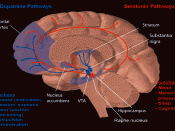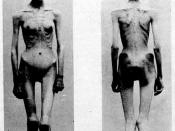Eating Disorders in Society Over winter break, I was in the locker room of my local gym and overheard a conversation between two middle school aged girls. They were weighing themselves and exclaiming that they needed to lose weight. One of the girls said that her and her mom were going on a diet and the other said that she needed to lose at least ten pounds. I was shocked, mainly because these girls were very petite as it was, and it also caused me to wonder why girls and women are so obsessed with female body image. You probably wouldn't hear middle school age boys talking like that in a locker room. It is no wonder why 90% of all eating disorder cases are women, while only 10% are men. Eating disorders affect women; specifically white women because of the way that Western Society views women, as well as pressure from family, the media, how men are viewed in society and cultural stereotypes.
There are two main types of eating disorders: Anorexia Nervosa and Bulimia. Anorexia is the intense fear of gaining weight although the anorexic is typically at least "15% below a minimal weight for their age"ÃÂ (Way, 5). She also has a distorted body image and will convince herself she is fat when she is emancipated. An anorexic may also experience amen rhea-missing three or more consecutive periods. Bulimia consists of binging and purging, often times a great deal of food. One of the main differences between anorexia and bulimia is that anorexics are in denial that they have a problem, while Bulimics know that they do and try to hide it.
One of the main causes behind eating disorders is the influence of society. In society, we develop certain ideologies about the way things should be...


